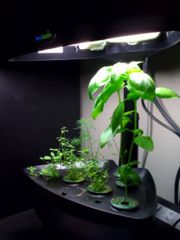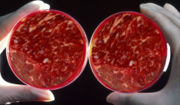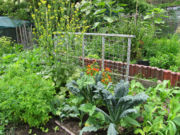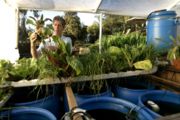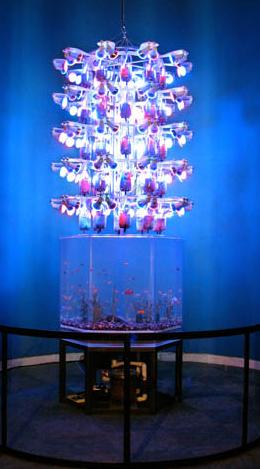Food
|
Many people believe that we are soon to face a global food shortage. Population is rising rapidly, with a billion people added in less than ten years. 40% of farming land has been depleted
 and rainforests have been cut down to make more room for farming. Farmers are moving into cities at the rate of over a million a week [1], and our appetite for meat is growing[2]. These trends means that food demand is rising, but there are fewer farmers to supply it, while the basis of our agricultural production is under strain. It would indeed seem that we are heading for a food crisis. and rainforests have been cut down to make more room for farming. Farmers are moving into cities at the rate of over a million a week [1], and our appetite for meat is growing[2]. These trends means that food demand is rising, but there are fewer farmers to supply it, while the basis of our agricultural production is under strain. It would indeed seem that we are heading for a food crisis.
But this story misses a key point: there are far better ways to produce food than the ones now in wide use. While it is true that conventional plough agriculture and monoculture is driving the world towards a food crisis, there are ways to grow food using very little land, very little labour and no pollution. The aim of this page is to explore these methods and show how they can comfortably sustain a growing population. Any food shortage is really a shortage of applying this know-how to food production. It is possible, with current know-how, to create a food-production system that can provide tens of billions of people with abundant, local, nutritious, tasty food, textiles and wood, while economizing water, restoring soil, building communities, saving energy, creating pleasing landscapes, preserving wilderness, stopping diseases, needing virtually no inputs and benefiting not just people, but the rest of the biosphere as well. Aeroponics is the art of growing plants with their roots in air rather than in soil. The roots are intermittently spraying with nutrient-enriched water. This allows for precise control of the amount of nutrients that the plants receive. The figures on Wikipedia show that growing plants hydroponically (with their roots in nutrient-enriched water) results in yields 50% to over 1700% higher than growing in soil. Aeroponics yields are higher yet [3] [4]. show that growing plants hydroponically (with their roots in nutrient-enriched water) results in yields 50% to over 1700% higher than growing in soil. Aeroponics yields are higher yet [3] [4].
By growing aeroponically indoors, we can create an environment that can be monitored and controlled electronically. This lends itself readily to automation. A controlled environment allows food to be grown year-round, independent of seasons. While only one harvest a year can be grown conventionally, constant-yield growth gives 4-30 harvests a year, depending on the plant. Growing indoors greatly reduces the threat of pests and plant-diseases, eliminating the need for pesticides. And best of all, by optimizing the nutrient flow, we can supply plants with the nutrients they need to produce the flavonoids that give them their flavour. With controlled growing, it is possible to achieve a more intense flavour than growing in soil. Aeroponics requires an input of water with dissolved mineral salts, but it uses these resources very efficiently. Hydroponics uses only 5-10% the water of agriculture [5], while aeroponics uses 65% less water than hydroponics and only a quarter the nutrients [6]. Such water-efficient growing will make huge difference if we want to preserve our water resources, as 69% of all our water use is for agriculture [7]. Both of the necessary inputs for aeroponics - water and minerals - are in enormous abundance on Earth. LEDs can efficiently satisfy the light requirements of plants. Experiments by the University of Manitoba found that LED lighting increases yields by about 40% [8]. LEDs could be useful in situations where sunlight is unavailable - such as in winter in regions far from the Equator, in underground or underwater dwellings, in cities where a demand for space means food must be grown on stacked shelves indoors, and in space habitats. Currently the main obstacle to large controlled-environment agriculture projects such as The Vertical Farm Project is the cost of energy for lighting. As LEDs become cheaper and more energy-efficient (as with recent developments in OLED and PHOLED technology) these projects become more and more feasible. Fibre-optic cables can pipe sunlight in from outdoors, significantly reducing the amount of energy needed. Omega Garden uses an innovative cylindrical design in which plants are constantly tilted so they have to adjust to gravity[9]. It is claimed that this method can result in a fivefold increase over other plants grown in the same conditions but without rotation. There are many tricks that can be used to increase yield in controlled-environment growing that are not feasible on farms. Increasing carbon dioxide concentration in the air can increase yield 30-50%. Supplementing with fulvic acid can increase yield over 30%. Plant hormones such as gibberellin increase yields significantly. Even with none of these tricks, a hydroponic garden can regularly grow 2kg of vegetables a day (more than enough to nourish a person) in 20 square meters [10]. An aeroponic garden using LEDs, CO2, plant hormones and fulvic acid could grow the same amount in perhaps half the space. Furthermore, it is possible to stack five layers of crops one on top of another in a 2m high system, reducing footprint fivefold. The surprising result is that in the near future, city-dwellers will be able to grow most or all of their own food in their kitchen - farming will not be necessary for food-production. Space colonists could also grow food locally using aeroponics and in-vitro meat.Dickson Despommier, an advocate of vertical, controlled-environment farming, has painted a picture of what controlled-environment growing might be like -
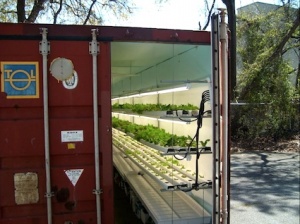 PodPonics is one existing proof-of-concept; it grows an acre's worth of food in a single 320 square foot (30m2) shipping container. Food produced in this way is local, fresh and delicious.
Moreover, a gas chromatograph will tell us when to pick the plant by analyzing which flavenoids the produce contains. These flavenoids are what gives the food the flavors you're so fond of, particularly for more aromatic produce like tomatoes and peppers. These are all right-off-the-shelf technologies. The ability to construct a vertical farm exists now. We don't have to make anything new." Algorithms could be developed and shared online to model how nutrient flow, timing, duration, intensity and color of light, and strains of plants used affects food yields and flavour. PlantLab is a company that is compiling exact, programmable specifications for growing various plants, but open-source methodology has proven to be a much faster way of compiling large streams of experimental data. Programming these algorithms into computers that control the LED lights and the nutrient flow in the aeroponic system would yield a truly automated food-production system that anyone could use to grow their own food indoors. All this technology exists currently, and is being constantly improved and refined. "Fifty years hence, we shall escape the absurdity of growing a whole chicken in order to eat the breast or wing, by growing these parts separately under a suitable medium." — Winston Churchill, 1931
In-vitro meat has already been created successfully [11], but there is still work to be done on making it efficient enough to do on a large scale and on getting the texture and taste right. Muscle grown in this way has never been exercised, so it has a wasted texture. However, researchers are confident they can overcome these challenges. The inventor of the technique estimated that its price fell by a factor of 30,000 in a period of 18 months[12] If this technique is perfected, it would be possible to grow millions of kilos of meat from cells taken from a single animal. This would require much less land, water and energy than raising livestock, and enable us to enjoy our steaks without animals dying or suffering. One study estimated that in-vitro meat would use 35-60% less energy than raising livestock, 80-95% less greenhouse gases and 98% less land. Precise control of the growth-medium would also allow us to create meat with a desirable nutritional profile (much like the controlled environment growing of plants described above). Along with aquaponics and sustainable aquaculture, this can take the demand off the oceans' limited fish stocks. The same method could also be applied to creating leather, fur and other animal products. Most food now comes from large farms that focus on just one or two crops or animals. This kind of farming requires constant inputs: fertilizer, pesticide, water, animal feed and other resources. It also produces a constant output of pesticide-contaminated water and other waste. It is sometimes assumed that growing food without fertilizers, pesticides or other chemicals that have unwanted consequences means growing them without any yield-increasing methods at all [13]. According to this argument, we need higher yields to feed a growing population, and we need chemicals to boost yields; organic agriculture is equated with low-yielding agriculture. However, there is an alternative farming method that is both high-yielding and organic. This method is permaculture and it uses ecological methods instead of chemical ones to boost yields. Many experts have stressed that to sustain a growing population in a way that is viable in the long-term, we need is sustainable intensification [14][15][16]. This refers to a method of agriculture that gives higher yields than industrial monoculture, has less impact on the environment, uses less water and requires fewer inputs. Happily, sustainable agricultural practices also tend to be more productive than non-sustainable ones. An analysis of 286 sustainable farming projects in the developing world found that yields doubled for most plants [17]. Permaculture is a system that uses many sustainable intensification technologies together. Sustainable intensification is being implemented all over the world, with a 50% increase in four years [18], and with entire countries like Cuba and Bhutan moving to sustainable systems. No inputs, no wasteWhereas industrial farms import inputs such as fertilizer and remove waste products such as pig effluent by mechanical means, permaculture designs the farm so that all inputs are provided on-site by another species, and all outputs are put to use. For example, a cow requires an input of grass, and creates an output of dung and urine. By spatially juxtaposing the cow and the grass, the cow's feed is provided by the grass and the grass's need for fertilizer is provided by the cow's manure and urine. This slashes the need for human or mechanical labour. A permaculture farm is an interconnected system of flora and fauna that recycles its own resources - an agroecosystem. In contrast with the large fields of single crops seen in industrial farming, permaculture favours complex patterns where different species are closely juxtaposed in space and time, allowing these synergistic interactions to happen. Integrated pest managementSpecies need protection from pests and predators. In a permaculture farm, this too is provided by other species, thus removing the need for artificial pesticides. This is known as integrated pest management Soil careIndustrial-style farming techniques deplete 6-24 kilos of soil for ever kilo of food grown [19]. This is a perfect example of a failure to think long-term; growing food in a way that diminishes the land's capacity to grow food is like killing the goose that lays the golden eggs. Permaculture (as its name suggests), focuses on the long-term fertility of the soil. Permaculture can create 20 kilos of newly fertile soil for every kilo of food grown[20]. Ensuring that soil has a thick spongy texture has immense consequences for world water use. Permacultural animal husbandryRanching is often blamed for environmental problems[21][22] because it uses a lot of land and water, can require large amounts of grain feed, antibiotics which leach into the environment and produces runoff that can pollute local water supplies. One argument against ranching is that it requires 16 kilos of grain to produce one kilo of beef, so to preserve food and avoid a food crisis, we must all become vegetarian [23]. All these points are valid criticisms of extensive grazing and feedlot farming. However, there is a way of raising livestock that is more in harmony with evolution's design. It is called mob-grazing, cell-grazing, or an 'animal tractor' and works by imitating the natural grazing patterns of herbivores. In the wild, herbivores huddle close together for protection from predators. In this 'mob', they mow down an area of grass in about a day, then move on to a different patch. The loss of predators has meant that herbivores spread out into a different, extensive pattern of grazing. This caused overgrazing and the destruction of grasslands in large parts of the world. The carbon released by the degeneration of these grasslands is a greater than from all the fossil fuels burnt by industry, prompting authors of a recent paper in Science to say that the loss of predators "may be humankind’s most pervasive influence on nature" [24][25]. 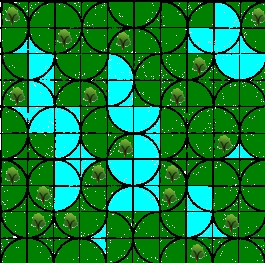 A large percentage of the world is covered by more-or-less featureless grass pastures dotted with cattle. We can increase the productivity of this land many times over by dividing it up into small cells and moving a succession of cattle and other animals around from cell to cell at very high densities. This will easily allow us to provide enough meat for a growing population. We can introduce more synergies by growing trees on the pasture (known as silvopasture) and by integrating aquaculture in ponds and lakes. Trees provide extra feed for the livestock in the form of leaves, while simultaneously yielding fruit, nuts or timber. Reeds on the edge of a pond grow much faster than grass does, providing even more feed, while simultaneously yielding fish and aquatic crops like taro. The benefits of this sort of grazing — for grass, for soil, for animals and for people — are remarkable. Manure fertilizes the grass, the mowing causes the grass to shed some of its roots, which then decompose and further improve the soil, and the animals' hooves break up the hardpan on the surface, further improving the structure of the soil. As mentioned in water-efficient agriculture, mob-grazing has been shown to increase the amount of water soil can hold by 775%. The name 'animal tractor' is apt; the herbivores mow and cultivate the ground more effectively than tilling, while also producing meat. This cultivation is particularly needed in sub-Saharan Africa and other places where extensive grazing patterns have made grasslands dry and dead. Anywhere that cell-grazing has been implemented, grasslands have recovered[26] and the soil and ecosystem holds so much water that drought is no longer a threat[27][28]. Another key advantage is that multiple animals can graze the same pasture in rotation. Polyface Farms grazes cows, turkeys, pigs, chickens, hens and rabbits on the same space by rotating them in time. This further benefits the soil and allows the animals to benefit from one another. For example, the maggots that grow in cow manure are a food source for chickens. Moreover, it obviously allows much higher productivity per unit of land. The argument that conversion of feed to meat is inefficient does not apply here, because in such a system cows only eat grass and weeds, not grain or anything else that is edible by humans. Therefore no useful food resources are being wasted. Besides, beef from grass-fed cows has a better nutritional profile than from grain-fed animals and is universally considered tastier. Cows also convert grass to meat much more efficiently than they convert grain[29]. Similar logic applies to other kinds of meat. We could say that in agroecology, the purpose of animals is to convert inedible grasses, insects, leaves etc. into edible meat. If we are to build a food system that provides high-quality food to all of humanity, it is essential that we use the 335.7 trillion m2 of pasture available to us for raising meat sustainably by converting these inedible grasses into meat. One estimate is that this would provide enough food for 1.3 billion people[30].
Productivity of permaculturePermaculture is not only an ecologically sound means of food-production, it is very productive. Permaculture expert David Blume makes a convincing case for the productivity of permaculture, writing, "In a good but somewhat sloppy design, you need about 500 square feet (46.5m2) per person maximum. In a very good design, 200 square feet (18.5m2) will do the job." John Jeavons (father of another school of permaculture called biointensive agriculture), makes more conservative claims of around 316-372 square meters [31] [32]. The 2011 UN report on the right to food notes that agroecology initiatives typically double yield within ten years while reducing the need for inputs like fertilizer. It also reports that agroecology projects generally come about as a result of peer-to-peer collaborative sharing of farming knowledge. While not as automated nor as productive as the aeroponics techniques described to the left, agroecology is a highly practical and advanced methodology that can play a role in making Spaceship Earth work for everybody. In time, it may become possible to automate agroecology by using sensors to detect when plants are ready for harvest, and having robots that can pick vegetables, prune trees and so forth. Hydroponics is growing plants in water. Aquaculture is growing fish in tanks. The disadvantage of hydroponics is the constant input of mineral nutrients it needs. The disadvantage of aquaculture is the difficulty of keeping the water clean. Aquaponics combine the two systems and thereby cancels out the weaknesses of both. In aquaponics, edible fish are grown in a tank. The fish eat the algae that will grow naturally in nearly any still body of water, or pond weeds can be grown. (Most aquaponic systems now use fish food, but methods under development eliminate the need for this input by cultivating duckweed or algae.) The fish effluent enriches the water with nutrients. This water then serves as the medium to grow hydroponic herbs and vegetables. The roots of the herbs and vegetables, and the bacteria that grow around them, clean the water for the fish. Both the fish and the plants can be eaten by humans. Some aquaponics systems also include a wormery, which uses the inedible parts of the plants to feed worms. The worms are then fed to the fish and the compost they produce can be used to nourish more plants, or made into compost tea to add more nutrients to the hydroponic system. This brings the system closer to a fully closed-loop that recycles all its waste. It should be apparent from this description that aquaponics is an extremely resource-efficient method of food production. No fertilizers are needed and there is no pollution. It is really the only sustainable way of producing fish; much more sustainable than conventional fish-farming and certainly more sustainable than current fishing practices. In theory an aquaponic system could be run without external input (though in practice fish food and calcium and other minerals often need to be supplied.) Aquaponics requires 10% the water of growing vegetables in soil, because the water is constantly recycled rather than draining away. This means that aquaponic farms nearly anywhere in the world can run on rainwater alone. Aquaponics is extremely productive. The plant yields compare favorably with hydroponics, and are much higher than growing in soil. Some research even points to the possibility of achieving much higher yields with aquaponics than even with hydroponics[33]. The aquaponics system at the University of the Virgin Islands[34] grows over 4000kg of tilapia and over 2500kg of okra yearly. This is more than enough fish for 35 people and more than enough vegetables for four people and it is all grown on just 500m2 of space. And this system does not even use space optimally; the 500m2 figure includes the gaps between the tanks. Improvements on the University of the Virgin Islands system have since been made [35][36]. Growing Power is an urban farm in Milwaukee. It uses several methods of growing, but aquaponics is the main one. On a footprint of just three acres (12,150m2), they grow enough food for 10,000 people[37]. Over the next few years, as a result of the research that is being done, aquaponic systems will become even more productive, more automated and require less input than current ones. This will make aquaponics even more appealing than it is now. Farm Fountain is 'a sculptural ecosystem you can eat'. It shows how aquaponics can be applied as a vertical farming method. The design, by Ken Rinaldo and Amy Youngs, is available under a Creative Commons license and their website gives instructions on how to build your own. The fish tank at the bottom produces edible fish and effluent-enriched water, which is circulated among the bottles above, where plants are grown hydroponically. A shortage of food is not the only problem. Over a billion people are overweight, and 300,000,000 are obese [38]. A third of all children born in the USA in 2000 are expected to become diabetic [39]. Metabolic syndrome Unfortunately, changing human behaviour is not as straightforward as finding a solution to an engineering problem. But what the suggestions given here can achieve is a change in the food environment. A decentralized food production system grows vegetables, eggs, meat, mushrooms and whole foods like that — not refined sugar products and processed foods like that. Hopefully, by transforming the food environment from the current one, where the most convenient food is bought in a bag, preserved with salt and flavored with sugar, to one where fresh, unprocessed fruits, vegetables, legumes, nuts, seeds, mushrooms, meat and fish are conveniently available locally, people's behaviour will change and we can mitigate obesity and diabetes as well as hunger. The high levels of control of the biochemical environment in techniques like aeroponics and in-vitro meat allow for precise control over the nutritional profile of the food produced. It should be possible with these methods to create the most nutritious food that can possibly be grown. Improving geneticsIn 1968 Paul Ehrlich wrote a book called The Population Bomb, warning that India and China were headed for catastrophic famines, as food production could not keep up with their expanding populations. Yet just six years later, in 1974, not only had the famines not materialized, but India and China were exporting grains. What changed? High-yield, drought-resistant, semi-dwarf varieties of wheat and other crops were introduced to these countries by an initiative headed by Norman Borlaug Other optimized strains have been introduced since then: NERICA rice has 2.5 times the yield of previously used strains. In 2002, a new strain of tomato was released in India that doubled yields and contains six times as much beta-carotene [40]. A new kind of pineapple was recently introduced in Cuba that has triple the yield of previous varieties [41]. There are countless more example like this, both for plants and livestock. Borlaug achieved huge increases in yield by selective breeding. Around seventy years earlier, Luther Burbank Up until now, genetic modification of food-plants has been quite simple. Generally, a single new gene has been inserted into a plant, to cause it to produce a nutrient or a pest-repellent, or convey some other desirable trait. But due to the rapid acceleration of genomic technologies, we are about to see more complex modifications, combining multiple desirable traits in a single species. Genetic modification can even allow plants to grow in soils they otherwise could not [42], opening up whole new swathes of farmland. Biotechnology can also create microbes that help soil conditions, pest control and plant growth. Certain bacteria can significantly improve the yield and nutritional profile of a wide range of plants [43] and we are likely to improve on these even more. Marker-assisted selection The recent surprising trend toward 'garage' biotechnology (or 'biohacking') has an important role to play in improving strains. Genetically engineered foods have often been restricted by intellectual property laws, and the companies that have developed genetically modified organisms have not had the incentive to improve food for the greater good. The solution to this is open-source biotechnology, where the biotechnologists are motivated by curiosity and contribution. It will be interesting to see what new biotechnologies that could help feed the world come out of hackerspaces like DIYbio and BioCurious. It is important to see genetic modification of food in its proper perspective. It is not, as some have claimed, a sufficient answer to the problems with our food system. Nor is it, as others say, inherently dangerous; the end products are not so different from those of selective breeding. Agronomic changes must change profoundly using agroecology, decentralization and other methods described on this page. Within such an improved system, genetically-modified plants have a role to play. Using a combination of selective breeding, hybridization, genetic modification and marker-assisted selection, it is possible to create the highest-yielding, fastest-growing, most compact, hardiest, most water-efficient, most nutritious, tastiest plants that have ever existed. Combined with the high-yield farming techniques described above, this can produce an abundance of high-quality food for everyone. But first, these optimized strains must be shared — Sharing genetic materialTo start growing food, you need a rootstock (seed, spores, chicks, calves etc.) which you then multiply. For example, if you obtain a trio of rabbits to breed, a year later you can have over a hundred rabbits. The self-replicating nature of biology means its supply is unlimited — therefore rootstock should be abundant. You will not suffer scarcity if you give just a few rabbits as a rootstock to your neighbour, your orchard will not be diminished if you give away a few pips, and a farmer growing fields and fields of rice can give free seeds to his neighbour. This is a perfect milieu for a gift economy Once optimized strains are created, they can be spread around the world through free peer-to-peer exchanges. Thus the genetic resources for agriculture can become free again. This project is already well underway. Several organizations are very active in free seed exchange, such as Via Campesina, The AgriCultures Network and innumerable local groups. In Cuba, every farming community - urban as well as rural - has a community genebank where plants are bred using techniques like marker-assisted selection, and then distributed. This could be done everywhere, or genetic material could be shared on the peer-to-peer basis just described. Local food growers can obtain free locally-adapted rootstocks from their neighbours, while more exotic fare can be obtained on websites where people give away free rootstocks, such as Bemushroomed for mushroom cultivators. Diversifying our food sourcesOne of the weaknesses of the modern food system is its overdependence on a few species. Nearly all our meat comes from just five species (cows, pigs, goats, chickens and sheep), and 75% of all our food comes from just 12 plant and animal species[44]. As a result, regions unsuited to cultivating these species either are unproductive, or resort to unsustainable irrigation or fertilization to force them to grow. If we put more food on the menu, we will inevitably find species better suited to particular regions. Taking full advantage of native fruit trees in the semi-arid regions of Africa has the potential to provide food and income for millions of people[45]. Another example is the mongongo nut, which grows in sand dunes, and could potentially produce a lot of food in the desert regions of the world. |
 [print version]
[print version]  [update]
[update]  [site map]
[site map]
